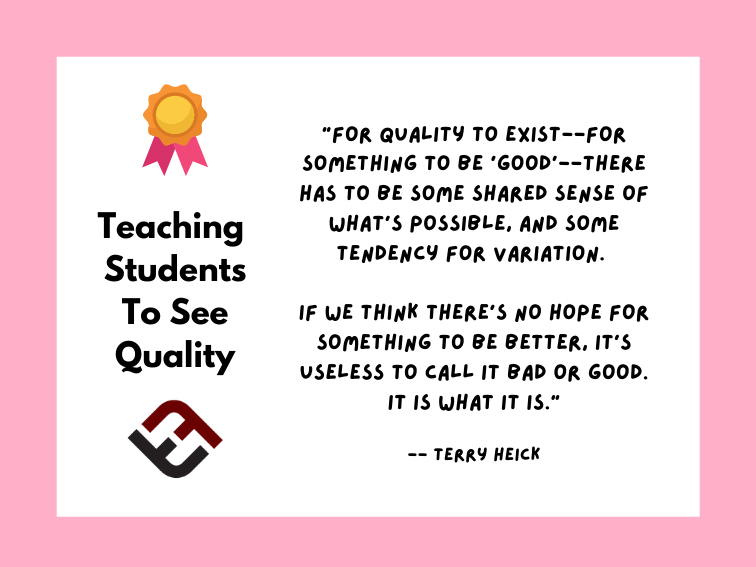
How To Teach Students To See Quality
by Terry Heick
Quality—you know what it is, yet you don’t know what it is. But that’s self-contradictory. But some things are better than others, that is, they have more quality. But when you try to say what the quality is, apart from the things that have it, it all goes poof! There’s nothing to talk about. But if you can’t say what Quality is, how do you know what it is, or how do you know that it even exists? If no one knows what it is, then for all practical purposes it doesn’t exist at all. But for all practical purposes, it really does exist.
In Zen and the Art of Motorcycle Maintenance, author Robert Pirsig talks about the evasive idea of quality. This concept—and the tangent “Church of Reason”–heckles him throughout the book, notably as a teacher when he’s trying to explain to his students what quality writing looks like.
After some struggling– internally and with students–he throws out letter grades altogether in hopes that students will stop looking for the reward, and start looking for ‘quality.’ This, of course, doesn’t turn out the way he hoped it’d might; the students revolt, which only takes him further from his goal.
So what does quality have to do with learning? Quite a bit, it turns out.
A Shared Sense Of What’s Possible
Quality is an abstraction–it has something to do with the tension between a thing and an ideal thing. A carrot and an ideal carrot. A speech and an ideal speech. The way you want the lesson to go, and the way it actually goes. We have a lot of synonyms for this idea, ‘good’ being one of the more common.
For quality to exist–for something to be ‘good’–there has to be some shared sense of what’s possible, and some tendency for variation–inconsistency. For example, if we think there’s no hope for something to be better, it’s useless to call it bad or good. It is what it is. We rarely call walking good or bad. We just walk. Singing, on the other hand, can definitely be good or bad–that is have or lack quality. We know this because we’ve heard good singing before, and we know what’s possible.
Further, it’s difficult for there to be a quality sunrise or a quality drop of water because most sunrises and most drops of water are very similar. On the other hand, a ‘quality’ cheeseburger or performance of Beethoven’s 5th Symphony makes more sense because we A) have had a good cheeseburger before and know what’s possible, and B) can experience a vast difference between one cheeseburger and another.
Back to learning–if students could see quality—identify it, analyze it, understand its characteristics, and so on—imagine what that requires. They have to see all the way around a thing, compare it to what’s possible, and make an evaluation. Much of the friction between teachers and learners comes from a kind of scraping between students and the teachers trying to guide them towards quality.
The teachers, of course, are only trying to help students understand what quality is. We describe it, create rubrics for it, point it out, model it, and sing its praises, but more often than not, they don’t see it and we push it closer and closer to their noses and wait for the light to come on.
And when it doesn’t, we assume they either don’t care, or aren’t trying hard enough.
The Best
And so it goes with relative superlatives—good, better, and best. Students use these words without knowing their starting point–quality. It’s hard to know what quality is until they can think their way around a thing to begin with. And then further, to really internalize things, they have to see their quality. Quality for them based on what they see as possible.
To qualify something as good—or ‘best’—requires first that we can agree what that ‘thing’ is supposed to do, and then can discuss that thing in its native context. Consider something simple, like a lawnmower. It’s easy to determine the quality of a lawnmower because it’s clear what it’s supposed to do. It’s a tool that has some degrees of performance, but it’s mostly like an on/off switch. It either works or it doesn’t.
Other things, like government, art, technology, etc., are more complex. It’s not clear what quality looks like in legislation, abstract painting, or economic leadership. There is both nuance and subjectivity in these things that make evaluating quality far more complex. In these cases, students have to think ‘macro enough’ to see the ideal functions of a thing, and then decide if they’re working, which of course is impossible because no one can agree with which functions are ‘ideal’ and we’re right back at zero again. Like a circle.
Quality In Student Thinking
And so it goes with teaching and learning. There isn’t a clear and socially agreed-upon cause-effect relationship between teaching and the world. Quality teaching will yield quality learning that does this. It’s the same with the students themselves–in writing, in reading, and in thought, what does quality look like?
What causes it?
What are its characteristics?
And most importantly, what can we do to not only help students see it but develop eyes for it that refuse to close.
To be able to see the circles in everything, from their own sense of ethics to the way they structure paragraphs, design a project, study for exams, or solve problems in their own lives–and do so without using adultisms and external labels like ‘good job,’ and ‘excellent,’ and ‘A+’ and ‘you’re so smart!’
What can we do to nurture students that are willing to sit and dwell with the tension between possibility and reality, bending it all to their will moment by moment with affection and understanding?
